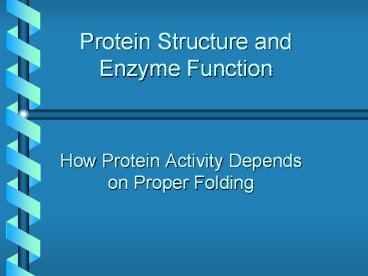Protein Structure and Enzyme Function - PowerPoint PPT Presentation
1 / 19
Title:
Protein Structure and Enzyme Function
Description:
Protein Structure and Enzyme Function How Protein Activity Depends on Proper Folding Four Levels of Protein Structure Proteins: Structure Primary structure = chain of ... – PowerPoint PPT presentation
Number of Views:124
Avg rating:3.0/5.0
Title: Protein Structure and Enzyme Function
1
Protein Structure and Enzyme Function
- How Protein Activity Depends on Proper Folding
2
Four Levels of Protein Structure
Tertiary(Folding by R-group interactions)
Primary(Sequence)
Quaternary(Two or more chains associating)
Secondary(Coiling by Hydrogen Bonding)
3
Proteins Structure
- Primary structure chain of amino acids
- Amino acids have common features
Carboxylic AcidGroup
AminoGroup
R
CentralCarbon
The R GroupDiffers for Each Amino Acid
4
Proteins Structure Forming the Protein Chain
Phenylalanine
Leucine
Dehydration Synthesis between COOH NH2
5
Proteins Structure Forming the Protein Chain
The Peptide Bond
Water
Phenylalanine-Leucine Dipeptide
6
(No Transcript)
7
Four Levels of Protein Structure
- Secondary Structure
- Folded structure due to hydrogen bonds between
the amino and acid groups of amino acids
C
N
C
N
H
O
H
O
or
O
H
O
H
N
C
N
C
8
(No Transcript)
9
Four Levels of Protein Structure
- Tertiary Structure
- Three dimensional folded structure due to
attractions and repulsions between R groups - Can involve
- covalent bonding hydrogen bonding ionic
interactions hydrophilic and hydrophobic
interactions
10
(No Transcript)
11
Four Levels of Protein Structure
- Quaternary Structure
- Association of two or more protein chains
eg. Hemoglobin is composed of 4 protein
chains 2 are called alpha
hemoglobin 2 are called beta
hemoglobin
12
Applying Your Knowledge
- Primary
- Secondary
- Tertiary
- Quaternary
- Which structure results from hydrogen bonding?
- Which structure involves an association of two or
more protein chains? - Which structure describes the linear sequence of
amino acids? - Which structure depends upon interactions between
the R groups of the amino acids?
13
Enzymes Assist in Biological Reactions
- Enzymes are biological catalysts.
- biological composed of protein
- or, rarely, RNA
- catalyst speeds up a reaction
- without being changed
- by the reaction
14
Properties of Enzymes
- Most enzymes are proteins.
- All enzymes are SPECIFIC for the reactants
(substrates) in the reactions that they catalyze.
- Enzymes speed up biological reactions by lowering
the activation energy for the reaction.
15
Enzyme-Substrate Interactions
Substrate
Substrate
1 Substrates enter active site
ActiveSite
2 Shape change promotes reaction
Enzyme
- Product releasedenzyme ready again
16
Activation Energy Controls Rate of Reaction
Activationenergy withoutcatalyst
Activationenergy withcatalyst
17
Properties of Enzymes
- Three dimensional structure of an enzyme
preserves its ACTIVE SITE - active site region on enzyme where
- reactants bind
- Conditions that can affect three dimensional
structure include heat, pH (acid/base balance)
and other chemicals (salt, charged ions)
18
Effects of Temperature and pH on Enzymatic
Activity
19
Applying Your Knowledge
- Active Site
- Activation Energy
- Enzyme
- Catalyst
- A biological catalyst is a(n) __________ .
- The region on an enzyme where reactants bind is
the _________. - Enzymes (raise or lower) the (1, 2, 3 or 4) of a
reaction.































